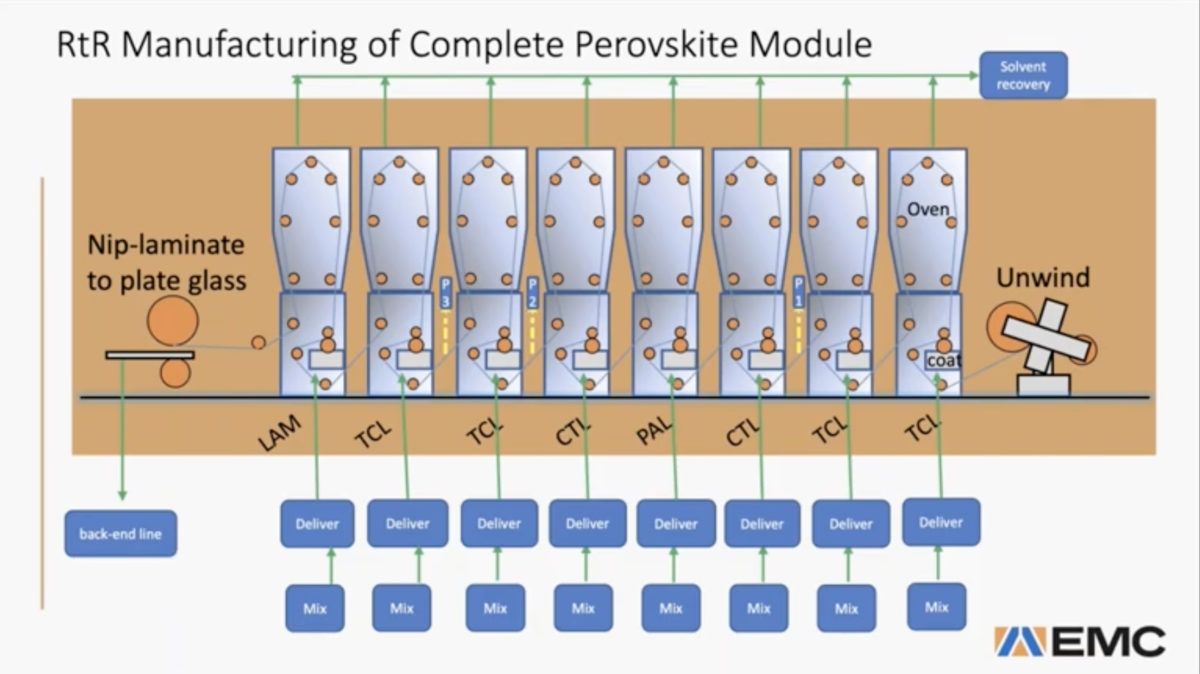New York State-based start-up Energy Materials Corporation (EMC) has gone public with plans for roll-to-roll printing of perovskite PV on glass.
The plan is backed by two partnerships—one with the Eastman Kodak Company for roll-to-roll printing and another with glass and ceramics business Corning, for flexible glass. EMC’s funding includes a $4 million research grant from the Solar Energy Technologies Office of the U.S. Department of Energy.
If the technology works, an eight-station roll-to-roll machine could produce 4 GW of perovskite PV material per year, according to Energy Materials CEO Stephan DeLuca, who was speaking in a webinar hosted by the U.S. Manufacturing of Advanced Perovskites (U.S. MAP) consortium. The capital cost of the EMC project would be around $100 million – $25 million per gigawatt of output capacity – based on perovskite with 20% conversion efficiency, said DeLuca—far lower than the projected cost of $400 million per gigawatt for silicon PV capacity suggested by the chief executive.
DeLuca shared the process diagram at the top of this story, showing flexible glass moving from right to left with eight stations printing transparent conductive layers (TCL), charge transport layers (CTL), a perovskite absorption layer (PAL), and laminating glue (LAM). Ink tanks are shown in blue at the bottom. On the left, the flexible perovskite-coated glass is laminated to plate glass. Ten separate lines would then make PV modules from the laminated plate glass.
EMC is conducting tests of a roll-to-roll pilot line at Kodak’s facility in Rochester, New York State.
“At Kodak, we manufactured film products up to 1.5m wide and as fast as 1,000 feet per minute,” states EMC chief technology officer Tom Tombs on the start-up’s website. While some Kodak film products had 15 layers, according to former Kodak program director Tombs, perovskite PV printing would require only six to eight layers, with the line operating at a much slower 100 feet per minute.
Energy Materials says hurdles have included identifying the right perovskite inks to use, the correct inks to use for other layers, and avoiding the need for a long residence time for annealing in an oven (labeled on the top right of the process diagram above), as the latter would slow line speed.

Image: Energy Materials Corporation
“Our scale-up experience on Kodak’s pilot line,” said Tombs, “has proven that roll-to-roll solar module production is well within the knowledge base of EMC and our partners.”
Energy Materials Corporation is a partner in the industry-wide U.S. MAP perovskite consortium alongside the Department of Energy's National Renewable Energy Laboratory and SLAC National Accelerator Laboratory; the universities of North Carolina at Chapel Hill, Toledo and Colorado, Boulder; the University of Washington-based Washington Clean Energy Testbeds; and solar manufacturers First Solar, Swiftsolar, Tandem PV, Hunt Perovskite Technologies and Bluedot Photonics.
By William Driscoll
This content is protected by copyright and may not be reused. If you want to cooperate with us and would like to reuse some of our content, please contact: editors@pv-magazine.com.



2 comments
By submitting this form you agree to pv magazine using your data for the purposes of publishing your comment.
Your personal data will only be disclosed or otherwise transmitted to third parties for the purposes of spam filtering or if this is necessary for technical maintenance of the website. Any other transfer to third parties will not take place unless this is justified on the basis of applicable data protection regulations or if pv magazine is legally obliged to do so.
You may revoke this consent at any time with effect for the future, in which case your personal data will be deleted immediately. Otherwise, your data will be deleted if pv magazine has processed your request or the purpose of data storage is fulfilled.
Further information on data privacy can be found in our Data Protection Policy.